|
San Francisco Opera may have already reached the zenith of this season (most reviewers thought so) with Händel's one and only "comic" opera Xerxes from 1738 – a serious composition with slight comedy touches. Like so many baroque operas, Xerxes deals with kings and courtiers, power and passion, in an exotic, allegorical way. The anonymous libretto tells about the Persian king with very few historical references. What is important here is that Xerxes obsesses over his brother's sweetheart and thinks he will be preferable to her because he is the king. Even a king with the eponym "The Great" sometimes has to learn the humbling lessons of humanity. The rest of the story follows the pattern of A loves B who loves C who is coveted by D, and ends with B marrying C while A must marry E whom he doesn't love but who loves him. There is a juicy role for a servant of the aristocracy, and you can see Mozart's Figaro and Don Giovanni and Rossini's Barber come right out of this Händel with its amusing libretto and inspired music.
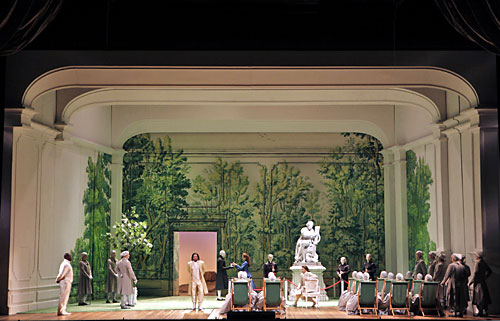 |
Xerxes begins with the most famous, aching love song of all baroque opera, the ode to an olive tree and its shade, "Ombra mai fu", and continues with similarly musical ravishments for almost Wagnerian length. It can take some patience to appreciate the curious structure of baroque opera, the sudden extreme mood shifts -- a lover's hope or bliss switch in an instant to jealous suspicion or rage; dreams of love are smashed, fantasies of revenge melted in seconds. The tyranny of fate is presented in extensive recitatives. Then each state of feeling is thoroughly explored in arias with multiple repetitions, perhaps not meant to deepen our rational understanding, but to make these emotions felt in musical terms. Emotions are presented like phenomena of nature, in the same repetitive form, one could say, as breezes, violent downpours of rain or thunder-claps. The spectators, forced to stand still and listen, may notice the variations within these patterns -- enhanced by the best singers with improvisations, on-the-spot invented embellishments and vocal surprises.
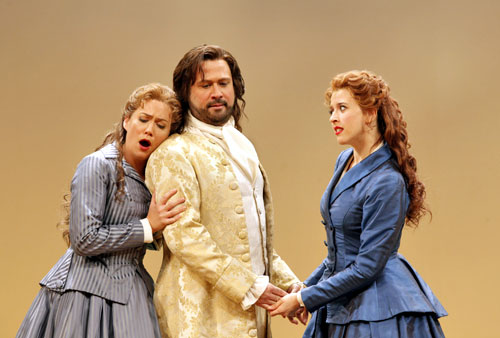 |
We were in luck at San Francisco Opera. The cast was superb; there wasn't a weak link in the chain. Led by two superstars, mezzo soprano Susan Graham (Xerxes) and countertenor David Daniels (his brother Arsamenes), the six principals displayed a full "bouquet" of coloratura colors and techniques. Graham sings warm, beautifully melted chains of embellishment with intense feeling, accompanied by always impeccably natural, seemimgly effortless acting. Daniels' tonality is more fixed, like a castrato's, a monotone of high, nasal fluting sounds, deliverd with astonishing mastery, beauty and inventiveness. But the voice is strangely detached from the rest of the singer who doesn't act. In his long career, Daniels has never managed to do more than produce his mellifluous sounds. One could say he is an operatic brother to Renée Fleming, although she still keeps trying.
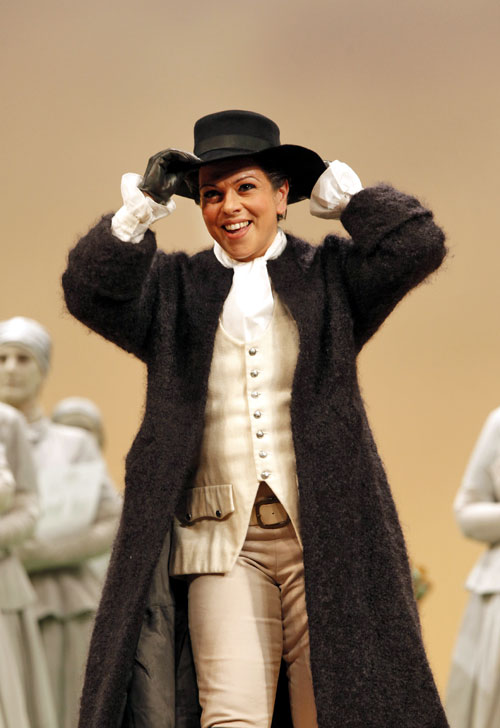 |
Italian contralto Sonia Prina was Amastris, the "foreign princess betrothed to Xerxes, disguised as a soldier," clad in trousers, with a dashing hat, singing her outbursts of jealousy with staccato bravura and a shot-gun pronunciation that brought the house down. The sweetheart of Arsamenes, Romilda (Lisette Oropesa) and her scheming sister Atalanta (Heidi Stober) were sung with pearly feminine sweetness and enough panache to accentuate the comic coloratura exaggeration of their moods and wiles. Both are gifted young singers to watch. Bass-baritone Wayne Tigges gave the army commander and father of Romilda such straight-faced vigor that the contrast with the rest of the cast seemed amusing. The cross-dressing worked wonders, as it should, especially when the upcoming Afro-American bass-baritone Michael Sumuel (a Merola alumnus) as the servant Elviro appeared as a flower girl and stole the show with his swift comic acting, exquisite movements and his even more exquisitely velvety voice.
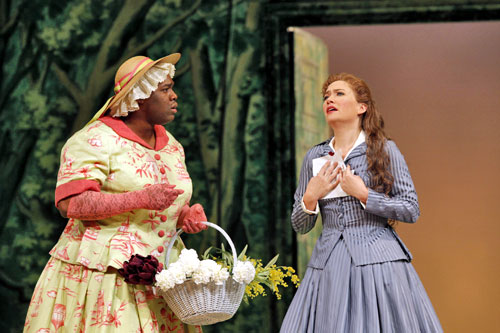 |
The production by Nicolas Hytner, renowned theater, opera and film director (The Madness of King George) comes with a long pedigree. Hytner (now director of the London's Royal National Theater) premiered Xerxes in 1985 at the English National Opera, where it won the 1985 Laurence Olivier Award for "Outstanding New Opera Production of the Year" and later introduced the rarely performed opera to happy American audiences in Houston and Dallas. This was San Francisco's first ever Xerxes.
A solemn group of courtiers is dressed like dusty statues in a park, all in grey with mask-like grey faces, an ironic reminder that around the bright light of the king there can only be human shadows. The opening scene in the castle garden, where Xerxes waters his beloved potted tree in a tender and also slightly pompous ceremony, sets the tone of the comedy. The stiff courtiers sit down in green beach lounging chairs to admire an aria performance by Romilda. In act II, they pantomime the fine etiquette around the new fashion of café tables, and are greatly disturbed by the drunken outbursts of Amastris over her betrayal by Xerxes, and the antics of Elviro, the outlandish flower girl, who is supposed to sneak a love letter to Romilda. The letter, of course, gets into all the wrong hands. In another ironic scene, the Persian King contemplates the model of a bridge that will allow his army to cross the Hellespont and conquer Europe, but after his vain attempts to conquer Romilda's heart, the bridge collapses. The sets by David Fielding charmingly play on the historic Vauxhall Pleasure Gardens which were opened in London in 1739 and, with their comical mix of exotic Persian temple elements and a statue of Händel, were the rage of the fashion crowd .
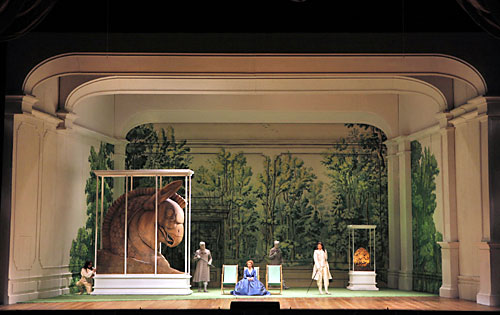 |
Xerxes was produced as a video back in the eighties. I happened to own the tape (which unfortunately is out of print) and was able to attest to the enduring freshness of Hytner's ideas. Some spice was added for the San Francisco revival by the new British stage director, Michael Walling, in his San Francisco debut. In Hytner's original staging, the comic notes were understated, leaving center stage to the emotional gravitas of the music. Walling's reprisal puts a welcome accent on the comedy. By highlighting the sheer madness of the love obsessions and delusions onstage he brings out the "mad" inventiveness of the music Händel wrote for his operatic comedy. This must be one of the reasons baroque opera is so popular in our post-modern era. Our psychological understanding, so used to complex psychic states, vague, contradictory moods, manic-depressive muddles, can find pleasure in the orderly baroque line-up of each emotion by itself, like a palette of pure spectral colors. Conductor Patrick Summers, however, at times had pains maintaining the order and keeping the less experienced sopranos from running ahead of the orchestra. But he managed, and he safely preserved the splendor and architectural balance of this late Händel masterpiece. The program notes reminded us that Beethoven, on his deathbed, "supposedly pointed to the complete edition of Handel's works and uttered something like, 'there lies the truth.'"
Photos - Courtesy San Francisco Opera
|


